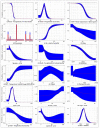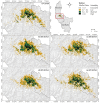Potential Current and Future Distribution of the Long-Whiskered Owlet (Xenoglaux loweryi) in Amazonas and San Martin, NW Peru
- PMID: 35883341
- PMCID: PMC9312142
- DOI: 10.3390/ani12141794
Potential Current and Future Distribution of the Long-Whiskered Owlet (Xenoglaux loweryi) in Amazonas and San Martin, NW Peru
Abstract
The IUCN has listed the long-whiskered owlet (Xenoglaux loweryi) as vulnerable due to the presence of few geographic records, its restricted range, and anthropogenic threats. Its natural history and ecology are largely unknown, and its distribution is widely debated; therefore, there is an urgent need for the real-time conservation of X. loweryi. In this study, 66 geo-referenced records of X. loweryi, 18 environmental variables, and the maximum entropy model (MaxEnt) have been used to predict the current and future (2050 and 2070) potential distribution of X. loweryi in the Amazonas and San Martin regions of northwestern Peru. In fact, under current conditions, areas of "high", "moderate", and "low" potential habitat suitability cover 0.16% (140.85 km2), 0.46% (416.88 km2), and 1.16% (1048.79 km2) of the study area, respectively. Moreover, under future conditions, the "high", "moderate", and "low" probability areas present profits and losses in terms of habitat suitability. Based on the environmental variables, this species mostly inhabits areas with a forest fraction with presence of trees with an emergent tree canopy of ~10-30 metres and depends on Yunga montane forest habitats with high humidity but it is not dependent on bare cover area, crops, or grasslands. Nevertheless, most of the current and future distribution areas are not part of the protected natural areas of Amazonas and San Martin. Additionally, the combination of climate change and anthropogenic activities contribute to further losses of this species habitat. Therefore, from the management point of view, corrective and preventive actions will help to preserve this species over time.
Keywords: MaxEnt; conservation; deforestation; protected areas; species distribution models (SDM).
Conflict of interest statement
The authors declare no conflict of interest.
Figures







Similar articles
-
Predictive Modelling of Current and Future Potential Distribution of the Spectacled Bear (Tremarctos ornatus) in Amazonas, Northeast Peru.Animals (Basel). 2020 Oct 6;10(10):1816. doi: 10.3390/ani10101816. Animals (Basel). 2020. PMID: 33036157 Free PMC article.
-
Identification of suitable habitat for Taxus wallichiana and Abies pindrow in moist temperate forest using maxent modelling technique.Saudi J Biol Sci. 2022 Dec;29(12):103459. doi: 10.1016/j.sjbs.2022.103459. Epub 2022 Sep 27. Saudi J Biol Sci. 2022. PMID: 36199517 Free PMC article.
-
Reduction in the potential distribution of bumble bees (Apidae: Bombus) in Mesoamerica under different climate change scenarios: Conservation implications.Glob Chang Biol. 2021 May;27(9):1772-1787. doi: 10.1111/gcb.15559. Epub 2021 Mar 11. Glob Chang Biol. 2021. PMID: 33595918
-
Forest Orchids under Future Climate Scenarios: Habitat Suitability Modelling to Inform Conservation Strategies.Plants (Basel). 2024 Jun 30;13(13):1810. doi: 10.3390/plants13131810. Plants (Basel). 2024. PMID: 38999650 Free PMC article.
-
The ecology, distribution, conservation and management of large old trees.Biol Rev Camb Philos Soc. 2017 Aug;92(3):1434-1458. doi: 10.1111/brv.12290. Epub 2016 Jul 7. Biol Rev Camb Philos Soc. 2017. PMID: 27383287 Review.
Cited by
-
Modeling the current and future habitat suitability of Neltuma pallida in the dry forest of northern Peru under climate change scenarios to 2100.Ecol Evol. 2024 Aug 27;14(8):e70158. doi: 10.1002/ece3.70158. eCollection 2024 Aug. Ecol Evol. 2024. PMID: 39206454 Free PMC article.
-
Drivers of Three Most Charismatic Mammalian Species Distribution across a Multiple-Use Tropical Forest Landscape of Sumatra, Indonesia.Animals (Basel). 2022 Oct 10;12(19):2722. doi: 10.3390/ani12192722. Animals (Basel). 2022. PMID: 36230461 Free PMC article.
-
Comparative study of ovarian development in wild and captive-reared long-whiskered Sperata aor (Hamilton, 1822).BMC Zool. 2023 Jul 24;8(1):10. doi: 10.1186/s40850-023-00172-x. BMC Zool. 2023. PMID: 37488631 Free PMC article.
-
Environmental Niche Modelling Predicts a Contraction in the Potential Distribution of Two Boreal Owl Species under Different Climate Scenarios.Animals (Basel). 2022 Nov 21;12(22):3226. doi: 10.3390/ani12223226. Animals (Basel). 2022. PMID: 36428454 Free PMC article.
References
-
- Neill J.P.O., Graves G.R. A new genus and species of owl (Aves: Strigidae) from Peru. Auk. 1977;94:409–416.
-
- Angulo Pratolongo F., Palomino Condori W.C., Arnal-Delgado H., Aucca Chutas C., Uchofen Mena Ó. Asociación Ecosistemas Andinos. American Bird Conservancy; Cusco, Perú: 2008. Análisis de distribución de aves de alta prioridad de conservación e identificación de propuestas de áreas para su conservación; pp. 1–149.
-
- MINAM, editor. MINAM Listado de Especies CITES Peruanas de Fauna Silvestre. Volume 1. Ministerio del Ambiente; Lima, Perú: 2018. pp. 1–135.
-
- Brinkhuizen D.M., Shackelford D. The Long-whiskered Owlets Xenoglaux loweryi of Abra Patricia. Neotrop. Bird. Mag. 2012;10:39–46.
-
- Lane D.F., Angulo F. The distribution, natural history, and status of the Long-whiskered Owlet (Xenoglaux loweryi) Wilson J. Ornithol. 2018;130:650–657. doi: 10.1676/17-061.1. - DOI
Grants and funding
LinkOut - more resources
Full Text Sources

